In a surprising display of courage, small birds will chase and harass much larger birds. This behavior, called “mobbing,” is a survival tactic used by songbirds. They do this to protect their nests, eggs, and young from threats.
From chickadees to red-winged blackbirds, these small birds face off against hawks, owls, and even humans. They are bold in trying to keep larger predators away from their territory.
Key Takeaways
- Small birds use territorial behavior and intimidation tactics to defend their nests and food sources from larger predators.
- Mobbing behavior is a collective defense strategy employed by songbirds to disrupt the hunting patterns of larger birds of prey.
- The timing of this aggressive behavior coincides with the increased vulnerability of nesting birds and their offspring during the spring breeding season.
- Small birds rely on their superior maneuverability and lack of surprise to counteract the size and strength advantage of larger predators.
- Mobbing does not usually result in injury to the targeted predator but serves to drive them away from the bird’s territory.
Understanding Bird Territory Defense Mechanisms
Birds have many ways to protect their homes, food, and where they breed. They do this to make sure they have what they need and to raise their young well. Each bird species has its own way to mark and guard its territory, showing how amazing they are.
One way birds defend their territory is by singing loudly. Mockingbirds are very aggressive when it comes to defending their nests. Red-winged blackbirds show off their bright red wing patches to tell others they own the area.
Birds also fight to keep their territory safe. They chase away intruders, hiss, snap their bills, and even attack. Goshawks have been known to hurt people badly when they defend their nests, as the Audubon Society has reported.
Some birds distract predators to keep their young safe. Killdeer, American Avocets, Red-capped Plovers, and Short-eared Owls do this. Seabirds like Fulmars even spray predators with stomach oil, which can harm them.
Not all birds defend alone; some do it together. Hooded Pitohui and its relatives in New Guinea are poisonous because of their diet. They keep predators away. Killdeer use camouflage to hide their nests.
The most intense defense happens during the nesting season. Birds fight hard to protect their breeding grounds and young. Learning about their aggression helps us understand and appreciate their amazing behaviors.
Why Do Small Birds Chase Big Birds?
Have you seen small birds like sparrows or chickadees chase and harass bigger birds like hawks or owls? This bold act is called “mobbing.” It’s a survival tactic for smaller birds to protect their nests and territories.
Nest Protection and Territory Defense
Small birds chase big ones to keep their nests and young safe. When eggs and hatchlings are vulnerable, they bravely face predators. Their speed and agility help them defend their territory against larger birds.
Seasonal Timing of Aggressive Behavior
The most intense mobbing behavior happens in spring and early summer. This is when the nesting season peaks. Smaller birds become very protective of their nests and young during this time.
Group Defense Strategies
Smaller birds use “mobbing” to chase away bigger predators. By working together, they make it hard for the larger bird to fight back. This group effort is a powerful way for small birds to protect their nests.
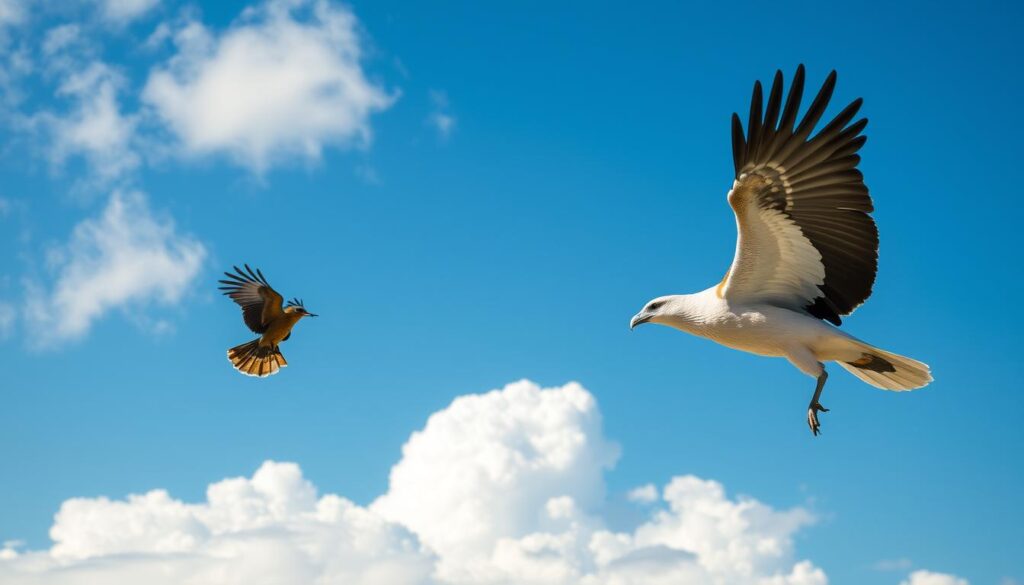
Even though small birds are at a size disadvantage, their speed and agility help them. Mobbing behavior is key to their survival and the future of their species.
The Science Behind Mobbing Behavior
Avian aggression towards larger birds is called “mobbing.” It’s a survival tactic that involves risk, communication, and teamwork. Birds use alarm calls to warn others and scare off predators.
This behavior makes it hard for predators to hunt. For example, American crows mob red-tailed hawks. Many bird species, like mockingbirds and crows, use mobbing to protect themselves.
Mobbing helps birds identify and learn about predators. It also makes it harder for predators to sneak up. This is because birds call in stronger predators to chase away the first one.
Research shows that how much birds mob depends on the predator’s threat. It also changes with the seasons. The environment, like forest density, affects how birds respond to mobbing calls.
But mobbing isn’t just for birds. Animals like bluegills and humpback whales also do it to protect their young. Mobbing shows how birds and other animals work together to stay safe from predators.
Common Bird Species Known for Mobbing
Mobbing is a common defense tactic among many bird species. These birds protect their territory and young by being aggressive towards larger predators. The red-winged blackbird, chickadee and titmouse, and crow and jay are known for this behavior.
Red-winged Blackbirds as Primary Mobbers
Red-winged blackbirds are known for their bold mobbing behavior. They chase and harass larger birds like hawks and eagles near their nests. Their attacks help protect their young and territory.
Chickadees and Titmice Behavior
Chickadees and titmice are small songbirds that mob predators. They work with other birds to chase away threats. Their high-pitched calls help gather more birds to defend their territory.
Crow and Jay Aggression Patterns
Crows and jays are intelligent and bold birds. They mob owls, seeing them as a threat. They use loud calls to coordinate their attacks, driving away predators.
These birds mob to protect their territory and young. They work together to fend off threats. Mobbing shows how birds adapt to survive.

| Bird Species | Mobbing Behavior | Targets |
|---|---|---|
| Red-winged Blackbird | Aggressive, relentless attacks | Hawks, eagles, owls |
| Chickadee and Titmouse | Enthusiastic participation, high-pitched alarm calls | Various predators |
| Crows and Jays | Intelligent, coordinated group attacks | Owls |
These birds use mobbing to defend their nests and young. Their territorial behavior and avian aggression help them face larger predators. Their teamwork shows the power of defense in the bird world.
Seasonal Patterns of Avian Aggression
As the breeding season comes, birds change how they act. Nesting season brings out territorial behavior and survival instincts. This is a big change in how birds interact with each other and their surroundings.
Research shows that in spring and early summer, birds are more protective and aggressive. This is because of hormonal changes. They become more hostile towards threats, like humans, to protect their nests and young.
“Territorial behavior is driven by the need to defend resources against competitors of the same species, which may lead to aggressive interactions and potential injuries when birds mistake reflections in windows, glass doors, and mirrors for intruders.”
The level of aggression can differ among birds and species. Things like food, population density, and hormones affect their behavior. These factors shape their territorial behavior and survival instincts during nesting season.
Knowing about avian aggression patterns is important. It helps wildlife lovers and people living near birds. By understanding these seasonal behaviors, we can better live with birds during the breeding season.
Survival Tactics: Speed and Maneuverability Advantages
Small birds use their speed and agility to defend against larger predators. They move quickly and change direction fast, making it hard for bigger birds to catch up. This skill helps them stay safe and outsmart their enemies.
Flight Patterns During Chase
Songbirds fly at about 30 mph during migration. Shorebirds can go up to 45 mph. But larger birds, like Canada geese, can fly even faster, between 20-50 mph. This difference in speed is key to small birds’ survival.
Defensive Strategies
- Small birds have wings that are mostly in the hand section, making them very agile. They can quickly dodge predators.
- Larger birds, with wings better for soaring, can’t move as fast as small birds. This makes it hard for them to catch up.
- Birds can adjust their wing shape to fly better. This helps them avoid drag and stay safe from predators.
Small birds use their speed and agility to keep larger predators away. They rely on being quick and alert, not on being big or strong. This shows how well they’ve adapted to survive against predators.
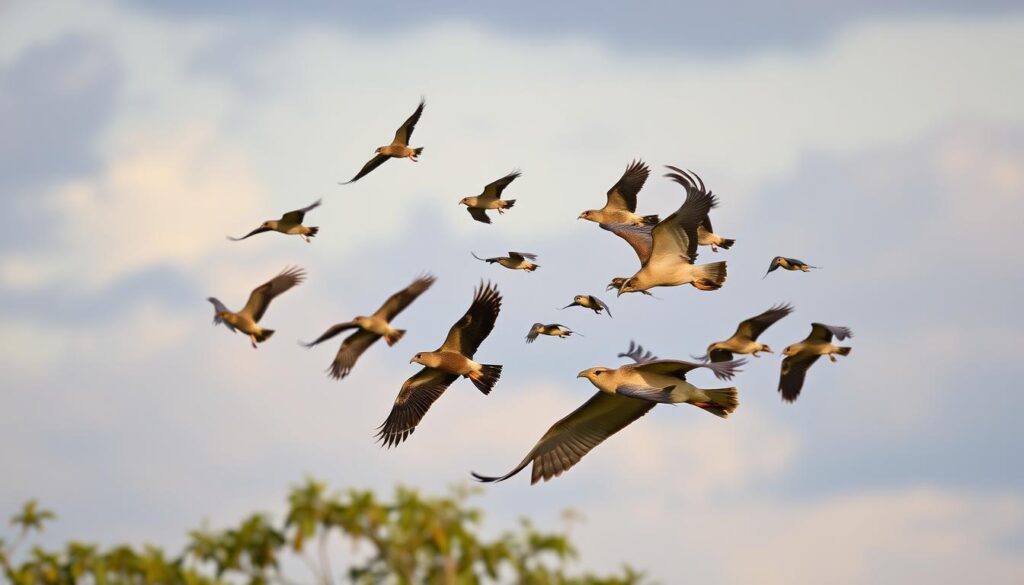
Predator Response to Mobbing
When smaller birds show avian aggression and predator deterrence through mobbing, the predator usually retreats. A group of smaller birds can make hunting hard and risky for big raptors like hawks and eagles. These birds often leave the area to avoid getting hurt, showing mobbing’s power as a survival instinct.
Research shows that how birds react to predators depends on the predator’s actions and how threatening it seems. For instance, Siberian jays change their mobbing calls and how loud they are based on the predator. They make more noise when facing a hawk, which is seen as a bigger threat.
| Predator | Mobbing Behavior | Outcome |
|---|---|---|
| Hawks | Intense mobbing, more calls | Predator retreats to avoid injury |
| Owls | Less intense mobbing, fewer calls | Predator leaves the area |
Mobbing is a key survival tactic for smaller birds. By working together and constantly bothering the threat, they keep their nests, young, and territories safe. This behavior is a vital part of the ongoing battle between predators and prey.
Communication During Mobbing Events
Birds have developed smart ways to talk to each other during mobbing events. These events happen when small birds gang up to scare away bigger predators. Their communication is key to territorial behavior, predator deterrence, and keeping the flock safe.
Alarm Calls and Warning Systems
When a predator is seen, birds make special alarm calls. These calls warn others nearby to join the mobbing effort. The sound of these calls tells other birds about the threat, helping them respond together.
Inter-species Cooperation
Alarm calls during mobbing are understood by many bird species. This helps with inter-species cooperation. Birds from different species can quickly understand and join the mobbing effort. Together, they can scare away the predator and stay safe.
The way birds communicate and work together to face predators is amazing. Their special communication helps small birds keep their territories safe from bigger predators.
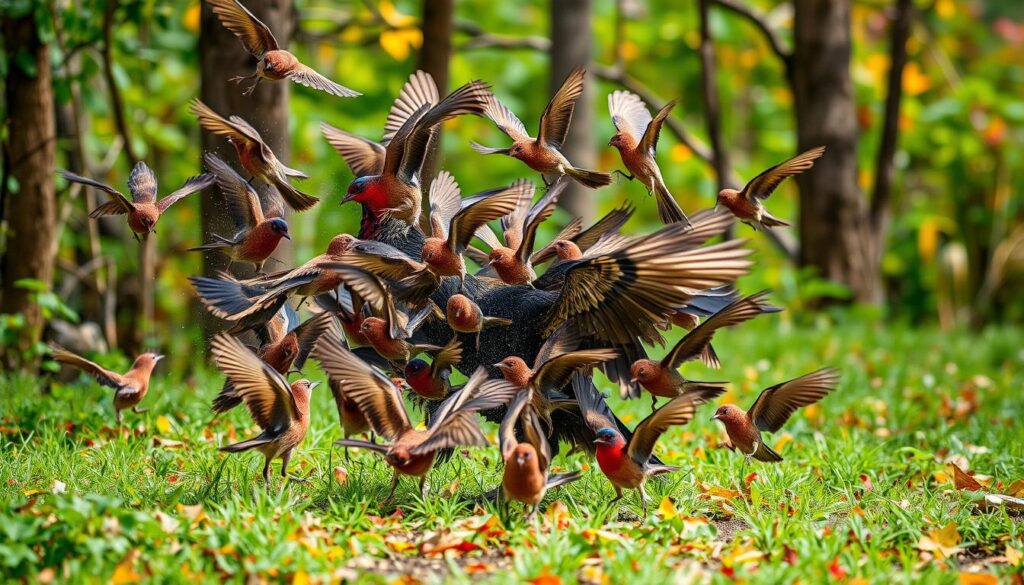
“The effectiveness of this communication system is evident in how quickly mobbing flocks can form and coordinate their attacks on potential predators.”
Risk Assessment: Danger vs. Reward
Birds use survival instincts and predator deterrence to stay safe. They chase bigger size disparity predators, even though it’s risky. This is because protecting their young or territory is very important.
The size, type, and closeness of the predator to their nests affects how birds react. During breeding seasons, birds take bigger risks to guard their young. They must decide if chasing the predator is worth the danger.
| Factors Influencing Mobbing Behavior | Impact on Risk Assessment |
|---|---|
| Predator Size | Smaller birds are more likely to mob larger predators when the size disparity is less pronounced. |
| Predator Species | Birds may be more willing to mob predators they perceive as less threatening, such as hawks versus owls. |
| Proximity to Nest | Birds will take greater risks to defend their young when the predator is closer to the nest. |
| Breeding Season | During nesting and fledgling periods, birds are more likely to engage in risky predator deterrence behaviors. |
The balance between risk and reward is key in mobbing behavior. Birds must weigh the danger of the predator against the need to protect their young and territory.
Impact on Predator Hunting Success
Small birds mobbing their predators has a big effect on hunting success. Their constant attacks and aggressive pursuit make it hard for predators to hunt. Often, predators have to leave their hunting spots because of this.
Territory Abandonment
Predators face attacks and alarm calls from mobbing birds. They usually leave the area to avoid these attacks. This predator deterrence helps protect nests and territories. It also makes the area safer for other birds, showing the wide impact of mobbing.
Hunting Pattern Disruption
The constant harassment from small birds messes up the predator’s hunting plans. Studies show that this can cut hunting success by up to 60%. The survival instincts and quick thinking of prey birds help them outsmart predators. This territorial behavior is a strong defense against larger birds.
Mobbing plays a key role in keeping the balance in their habitats. By defending their territories and nests, small birds ensure their survival. They also help the well-being of other birds in their community.
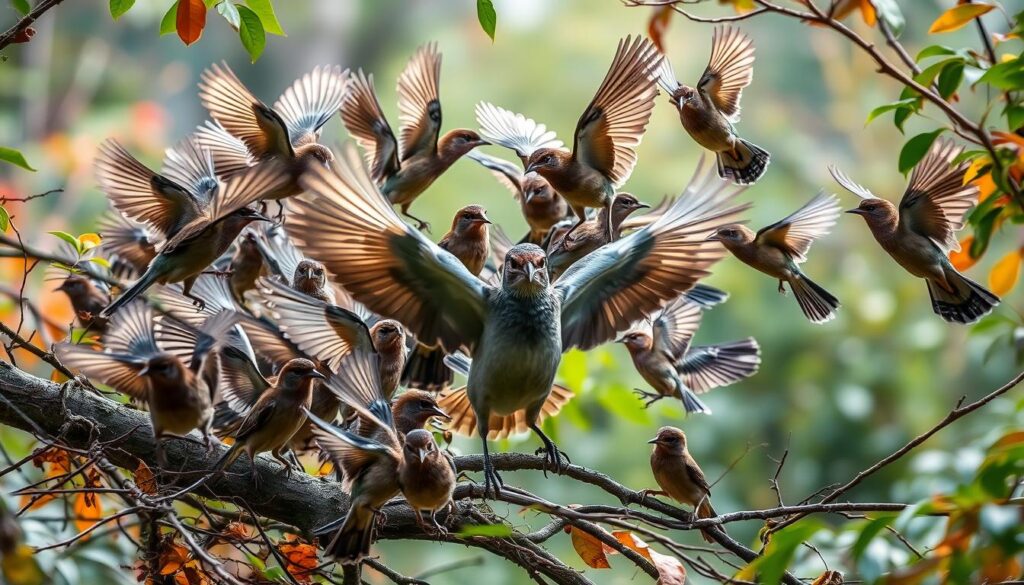
Nesting Season Defense Intensification
As nesting season nears, birds show a big increase in defense. They become more aggressive to protect their eggs and young from predators. This means more mobbing events as parents risk more to keep their nests safe.
Nest predation is a big problem for ground-nesting birds. It affects where they choose to nest. Shorebirds, for example, use different ways to defend their nests. Larger, monogamous birds are often aggressive, while smaller, polygamous birds use tricks.
Shorebirds with single parents show certain defense patterns. These patterns might be influenced by genetics and energy needs. When their chicks are young, they defend more than when they are eggs. The number of gull intrusions also goes up with more predation.
Northern Flickers, a type of woodpecker, get more defensive during nesting. Both males and females fight to protect their nests and mates. They spend more time looking for food and less time sitting on eggs as their brood grows. Bad weather makes them forage less.
The nesting season defense is key for many birds. It helps them protect their young from threats. This is a vital time for territorial behavior and survival.
Urban vs. Rural Mobbing Behaviors
Territorial behavior, predator deterrence, and survival instincts are key in bird mobbing. Birds in cities and countryside face different challenges. This affects how they mob.
In cities, birds are used to people but still watch out for birds of prey. They might not mob as much as they would in the countryside. Instead, they focus on keeping birds away from the sky.
Rural birds, however, mob more intensely. They have fewer people around and more natural threats. They must defend their territory and young from many dangers. This leads to more aggressive mobbing.
| Characteristic | Urban Birds | Rural Birds |
|---|---|---|
| Tolerance to Human Presence | Higher | Lower |
| Intensity of Mobbing Behaviors | Lower | Higher |
| Focused Threats | Avian Predators | Diverse Natural Predators |
Mobbing is a vital survival tactic for birds in various settings. It shows how birds adapt to their environments. By studying urban and rural mobbing, we learn more about birds’ territorial, predator-deterrent, and survival behaviors.
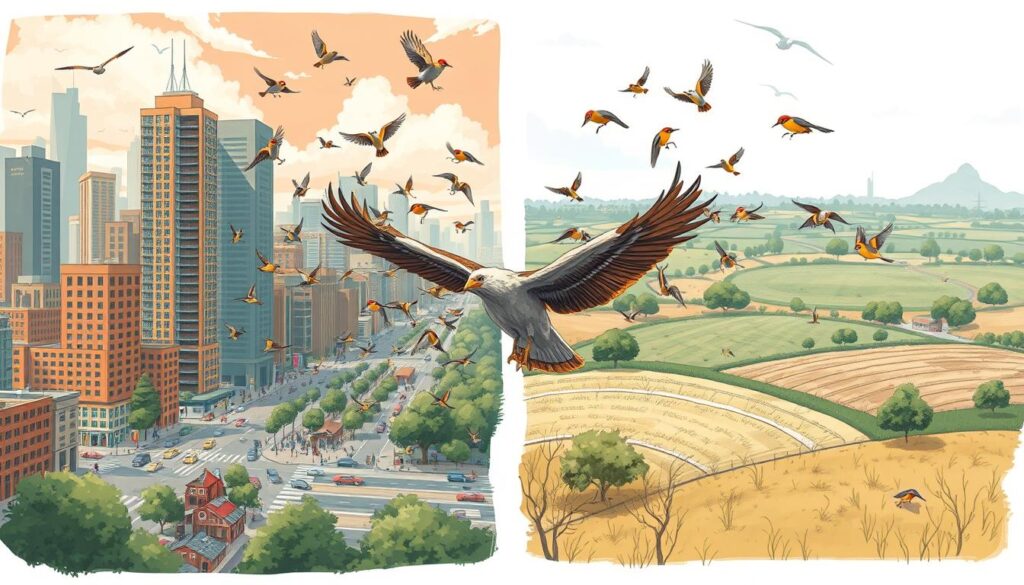
Conclusion
Small birds chasing big birds is a fascinating survival tactic in the bird world. This behavior, called mobbing, helps protect nests, young, and territories from predators. It shows how birds use complex communication and teamwork to stay safe.
This mobbing behavior is key to understanding bird ecology and territorial defense. It reveals how birds navigate and interact with each other. The data collected helps us see the complex social structures within bird communities.
As we learn more about why small birds chase big ones, we see the need for more research. Studying these survival tactics helps us appreciate birds’ resilience and adaptability. It deepens our understanding of the natural world.
FAQ
Why do small birds chase big birds?
Small birds chase big birds to protect their homes, eggs, and babies. This is especially true in spring and early summer. They use a strategy called “mobbing” to scare away larger birds from their areas.
What is the purpose of territorial behavior in birds?
Birds fight for territory for many reasons. They want to attract mates, guard food, and protect their nests. Each species has its own way of defending its territory, like mockingbirds or red-winged blackbirds.
They use loud calls and dive-bombing to scare away intruders. This includes bigger birds and even humans.
How does the timing of nesting season affect avian aggression?
Birds get more aggressive when they’re nesting. This is because of the breeding cycle. In spring and early summer, they’re more protective of their young.
This makes them more likely to attack bigger birds that might threaten their nests.
What are the key survival tactics used by small birds during mobbing?
Small birds are fast and agile when mobbing. They dodge and change direction quickly. This makes it hard for bigger birds to catch them.
It’s not about being big or strong. It’s about being quick and alert.
How do predators typically respond to mobbing behavior?
Predators usually run away from mobbing birds. They don’t want to get hurt or waste energy. Even big birds like hawks and eagles will leave rather than face a mob.
This shows how effective mobbing is for small birds.
What role does communication play in mobbing behavior?
Communication is key in mobbing. Birds use alarm calls to warn others and get help. These calls are similar across species, helping them work together.
This teamwork is why mobbing flocks can quickly form and attack predators.
How does the urban vs. rural environment affect mobbing behaviors?
Mobbing behaviors change depending on where birds live. Urban birds might be more used to people but still watch out for birds. Rural birds tend to mob more, possibly because they face more natural threats.
This shows how mobbing is a vital survival tactic for birds, no matter where they are.


купить аккаунт https://birzha-akkauntov-online.ru/
магазин аккаунтов https://marketplace-akkauntov-top.ru/
магазин аккаунтов маркетплейс аккаунтов
купить аккаунт продать аккаунт
биржа аккаунтов https://prodat-akkaunt-online.ru
биржа аккаунтов https://kupit-akkaunt-top.ru
продажа аккаунтов https://pokupka-akkauntov-online.ru/
Profitable Account Sales Account marketplace
Account Trading Service Ready-Made Accounts for Sale
Account Selling Service Account Exchange Service
Accounts market Account Buying Platform
Sell accounts Account marketplace
Ready-Made Accounts for Sale Secure Account Sales
Website for Selling Accounts Accounts market
Account trading platform accountsmarketplaceonline.com
Accounts market Account exchange
Ready-Made Accounts for Sale https://socialmediaaccountsale.com
buy and sell accounts gaming account marketplace
accounts market account catalog
buy account socialaccountssale.com
account trading service account marketplace
account sale account exchange service
profitable account sales account catalog
database of accounts for sale account marketplace
secure account sales https://accountsmarketdiscount.com
account buying platform https://discountaccountsmarket.com
account selling service accounts marketplace
sell account marketplace for ready-made accounts
gaming account marketplace find accounts for sale
account trading https://social-accounts.org
account exchange account acquisition
accounts marketplace social media account marketplace
account selling platform ready-made accounts for sale
verified accounts for sale verified accounts for sale
accounts for sale sell account
profitable account sales purchase ready-made accounts
verified accounts for sale sell accounts
secure account sales accounts market
sell pre-made account account exchange service
buy account database of accounts for sale
ready-made accounts for sale find accounts for sale
sell accounts account acquisition
profitable account sales database of accounts for sale
database of accounts for sale account selling platform
profitable account sales https://accounts-offer.org/
buy accounts https://accounts-marketplace.xyz/
account trading service https://buy-best-accounts.org/
secure account purchasing platform accounts market
account trading service https://accounts-marketplace.live/
account selling platform https://social-accounts-marketplace.xyz
account trading service https://buy-accounts.space
find accounts for sale https://buy-accounts-shop.pro
verified accounts for sale buy-accounts.live
sell pre-made account https://social-accounts-marketplace.live
marketplace for ready-made accounts https://accounts-marketplace.online
account exchange service https://accounts-marketplace-best.pro
купить аккаунт https://akkaunty-na-prodazhu.pro/
маркетплейс аккаунтов rynok-akkauntov.top
биржа аккаунтов kupit-akkaunt.xyz
купить аккаунт https://akkaunt-magazin.online/
купить аккаунт akkaunty-market.live
продать аккаунт https://kupit-akkaunty-market.xyz/
маркетплейс аккаунтов https://akkaunty-optom.live/
маркетплейс аккаунтов соцсетей https://online-akkaunty-magazin.xyz
маркетплейс аккаунтов https://akkaunty-dlya-prodazhi.pro
купить аккаунт купить аккаунт
buy facebook old accounts fb account for sale
facebook accounts for sale fb accounts for sale
buy facebook accounts for advertising https://buy-ad-account.top
buy old facebook account for ads https://buy-ads-account.click
buy facebook ads accounts https://ad-account-buy.top/
buying facebook accounts facebook ads accounts
buy facebook accounts for advertising cheap facebook accounts
Предлагаем вашему вниманию интересную справочную статью, в которой собраны ключевые моменты и нюансы по актуальным вопросам. Эта информация будет полезна как для профессионалов, так и для тех, кто только начинает изучать тему. Узнайте ответы на важные вопросы и расширьте свои знания!
Узнать больше – https://medalkoblog.ru/
В обзорной статье вы найдете собрание важных фактов и аналитики по самым разнообразным темам. Мы рассматриваем как современные исследования, так и исторические контексты, чтобы вы могли получить полное представление о предмете. Погрузитесь в мир знаний и сделайте шаг к пониманию!
Ознакомиться с деталями – https://medalkoblog.ru/
buy aged facebook ads accounts https://buy-ad-account.click
buy fb ads account facebook accounts to buy
buy google adwords account google ads reseller
buy aged google ads accounts buy-ads-accounts.click
fb accounts for sale buy fb ad account
buy google ads invoice account https://ads-account-for-sale.top
buy verified google ads accounts https://ads-account-buy.work
buy google ads account buy google ad threshold account
buy google ads verified account https://buy-account-ads.work
buy old google ads account buy google ad threshold account